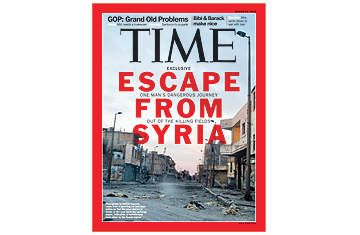
(4 of 6)
As the cease-fire drew to a close, Daniels and Espinosa returned to the building where they were hiding and found five ambulances from the Syria Arab Red Crescent (SARC) parked outside. "We aren't here for you," one driver told the journalists. He offered to take them to the ICRC convoy, but SARC would first need to hand the group over to the regime forces, something the journalists believed could endanger them. "We are here to get wounded Syrians out. The ICRC is just outside Bab Amr, 500 meters away. You can talk to them."
Daniels borrowed the ambulance's radio set and raised the ICRC head in Syria, Marianne Gasser. She told him, "We're negotiating to go into Bab Amr. It should be fine."
Minutes passed. On the radio, Gasser told Daniels, "Good news. One ambulance will stay, and I will come to you with two other ambulances." But then one of the paramedics with Daniels suddenly said, "We have been ordered to leave now."
That sent Daniels into a panic. "You can't leave us! One ambulance is supposed to stay."
"We'll pick you up later" was the response as the SARC drove off.
That night the government unleashed several rockets, seemingly aimed at the journalists' hideout. Daniels suspects the presence of the ambulances tipped off the regime to the journalists' whereabouts. The attack continued through the night and into the morning. "We were really scared," says Daniels. Word had reached them from the French government that it was imperative that they leave Bab Amr. "We decided the very next ambulance that came, we had to go with them."
But none came.
Making a Break for the Border
"We were going crazy," Daniels recalls. "we knew that security forces were closing in on Bab Amr. They were trying to enter close to our house. We knew from the sound of the tank shelling--the level was low, there were booms--that they were very close. We learned that the ambulance was supposed to come on Monday at noon. But they had not come Saturday or Sunday, so we no longer trusted them."
By the evening of Sunday, Feb. 26, the four colleagues made a decision: they would escape the way they came, through the tunnel. They taped Bouvier to a stretcher and four Syrians took turns carrying her, two at a time, with Daniels beside them. They had to crouch as they walked through the pipe, and they fell farther and farther behind Conroy and Espinosa, who were with several Syrian activists, some of them on motorbikes. (Conroy's injuries did not require him to lie flat and made him easier to transport.) Suddenly there were explosions at the tunnel's end. The army was onto them. People fled, screaming.
Daniels found himself alone in the dark with Bouvier; both were breathless and terrified. A rebel fighter approached, mumbling, "No problem, no problem," and placed a Kalashnikov rifle across Bouvier's slender body, warning them to cover their faces from a possible gas attack. Then he ran off. The gun ($1,600 on the black market) was a gift for them to defend themselves.
